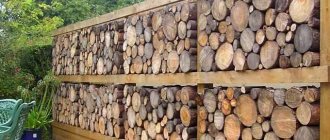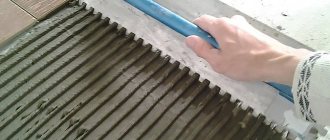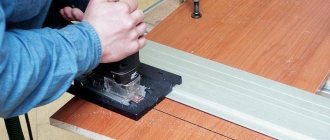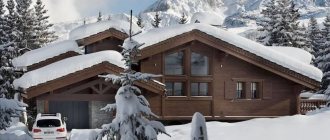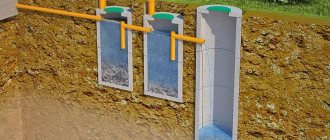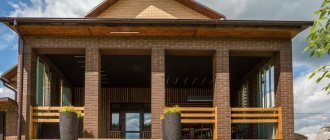You already know that fence supports can be made using different materials. It could be: brick, wood, metal . How to paint the stove after plastering with tile adhesive? Fence posts can be painted using specially developed products for each type.
This is both a decorative treatment and protection from various external factors.
Painted metal fence post Return to contents
The process of painting poles and wooden fences
Don't forget about impregnation, which will protect the pillars from high humidity.
This process requires special care. It is necessary to work with them before installing the pillars. The part of the pillars that will be in the ground should be treated with bitumen impregnation. All operations should be aimed at extending the service life of structures.
Bitumen impregnation will contribute to the resistance of the fence base to water, alkaline and acid reactions. It is advisable to repeat this procedure twice with a break of a day.
The bitumen layer must be hard. Also, try to dry the posts before painting. Humidity should reach 15%! Why should this be done?
Because the wood will always be in contact with moist soil. And so, when painting dry wood, the moisture content of the wood is adjusted. Be sure to sand the surface of the wooden fence.
This will reduce the amount of impregnation used and better protect the wood being treated.
Never perform such operations in wet weather. The top of the posts is treated with varnish with an ultraviolet absorber or other paint that you prefer.
These fence posts can be painted using several options. The simplest and least expensive is coating with bitumen varnish. The varnish can be diluted and evenly applied to the posts. Drying takes three to four hours.
The posts will have a shiny black color. You can simply use metal enamel. How to paint plastic plinth for PVC panels?
But this method is short-lived.
Paint “Special Forces”
The most expensive and reliable method is considered to be treating the surface of poles with Spetsnaz paint. It is advisable to work with a small brush.
This process requires following simple rules, under which you will achieve good results:
- To get started, you need to prepare your workspace. It is advisable to paint on a warm and dry day.
- There should be no vegetation near the pillars.
The process of painting metal fence posts
- Take solvent and a rough brush and remove the oil layer from the surfaces. If there is rust or oxidation on the pillars, then they also need to be removed.
- If the poles are dirty, make a soapy solution, wash them, and then rinse them. After this, dry and remove any existing rust.
- Degrease with white spirit.
- The advantage of this paint is that the surface of the pillars does not need to be primed. This paint is applied two to three times. After drying each layer.
By the way, Spetsnaz paint can also be diluted with solvent 647. There are 900 g of paint in a can. Therefore, it is quite possible to paint 12 pillars.
We recommend: Enamel PF-115: technical characteristics and application
Try to purchase such products only in specialized stores.
Other processing methods
Some owners simply prime the pillars with GF-021. Based on their experience, they state that although coating in this way is cheap, it has good protective and decorative properties.
You can combine primer with paint. Apply primer to the surface. Let it dry. After that, work with the paint. You can also use options for painting, choosing from oil, alkyd, acrylic, and polyvinyl paints.
All of them have good contact with metal structures.
Be sure to have a water-based degreaser, a brush with coarse bristles, and a wire brush in your arsenal. You can also buy paint based on epoxy resin. Don't forget the solvent.
Rules for painting fences and posts
- Windy and rainy weather is not suitable for painting the fence.
- The scorching sun is not the best condition for painting.
- Paint on a cloudy and dry day.
- Apply primer first, then paint after completely absorbed.
- First the pillars are painted, then the entire fence .
- For inaccessible areas of the surface, use brushes.
For accessible ones - sprayers or other devices.
- Be sure to paint the joints and grooves well.
- Paint only with high-quality materials.
- Before painting metal surfaces, it is necessary to treat them and remove rust so that it cannot spread under the paint layer.
- Try to apply a primer and after it dries, start painting. Experts advise applying the primer three times.
- You don’t have to treat concrete pillars with anything, just paint them. The only thing you can do is to clean the posts, like the entire fence, from dust with a brush.
- Follow the instructions when painting.
- Galvanized poles are coated with epoxy resin paint. It dries within two hours. After this, apply another coat of paint.
- Aluminum and galvanized structures are coated with dispersion solutions.
If you decide to make the pillars white
This is a very complex color. In this option, it is necessary to approach priming and cleaning with special care, because all defects will appear. It is better to use paint with a whitening effect if you want to paint wooden posts. In general, use dark colors. On such surfaces, distortion is less visible.
Try to make the fence delight both you and passers-by with its beauty and well-groomed appearance.
Additional Information:
- Posts to be painted must be clean and dry. If they are dirty, they should be washed with soapy water and rinsed with clean water.
- After the pillars have dried, use a brush to remove rust from their surface.
- Cleaned supports should be wiped with a cloth soaked in solvent. This will allow you to degrease the surface before applying paint.
- If the bitumen varnish is very thick, it can be dissolved in white spirit.
- Apply varnish to the surface of the post with a brush. After four hours it will be completely dry and the pipe can be touched.
Transverse logs are attached directly to the pipes by welding, or guides for fastening are welded onto the pipes. The guides can be made in advance by welding them to a clamp, which is put on the pipe and tightened with a bolt. With this installation option, an insulating pad made of cotton material or a special plastic lining suitable for the diameter of the pipe is placed under the clamp.
Before painting, the metal surface should be primed. For this purpose, GF-021 or similar ones are most often used. How to paint metal fence posts to prevent them from rusting? Its color is gray and red-brown.
To reduce the amount of paint used, a more suitable primer is selected. It is applied to a dry, clean surface with a brush, roller or using a spray gun in 1-2 layers. After the primer has dried, begin painting. To prevent the primer from showing through, the paint will have to be applied in two layers.
If the fence posts are treated with antiseptics before it is installed, then it must be painted after installation. Before applying the paint composition, you should make sure that the fence support posts are dry, there are no bugs in them, and there are no traces of mold on their surface. Before painting, each post is thoroughly wiped with a rag and, if necessary, treated with an additional layer of antiseptic.
How to treat metal fence posts
- Bitumen mastic
- Bitumen varnish
- Paint treatment
- Paint "Special Forces"
- General rules for painting work
Of the various types of posts used to build fences in summer cottages, pipes are used in most cases.
Firstly, the material is from a moderate price category, durable, easy to use. Secondly, it combines perfectly with other materials. Depending on the type of barrier, different types of pipes are selected. Use round, rectangular and square. Round ones are a little cheaper, but square or rectangular ones are stronger and easier to work with.
Painting fence posts will not only give the fence an aesthetic appearance, but will also protect the pipes from corrosion. Regardless of whether the material was used or new, the preparation requirements are the same.
To pre-treat pipes you will need:
- metal brush;
- brushes for power tools;
- grinding wheels;
- sandpaper;
- personal protective equipment.
The treated surface is thoroughly cleaned of rust and dirt. A suitable tool for this purpose is selected. Washing may be necessary to remove old paint. The stores offer a wide range of removers for old paint.
Suitable types of primers
The main purpose is to protect metal from corrosion and environmental influences. Helps strengthen the structure, increases the degree of adhesion. Apply before painting.
Depending on the composition and technical characteristics, it happens:
- Isolating. This includes primers marked EP-0010, GF-021. The first is epoxy putty used to level the metal surface. It is characterized by high strength, adhesion, resistance to moisture and chemical solutions. The second is used as a pre-treatment of metal before painting with enamel. Contains anti-corrosion ingredients.
- Phosphating. VL-02 belongs to this category. Suitable for all types of metal. The product is greenish-yellow in color. Apply after cleaning the surface from dirt, dust, and degreasing.
- Passivating. These include GF-0119. The base is alkyd varnish with the addition of anti-corrosion and stabilizing substances. Tolerates temperature changes well. Has high adhesion. Color – red-brown. Apply before painting with enamel.
- Protective. This is the primer EP-0284. Forms a durable film on the surface, which makes the structure resistant to mechanical damage, moisture and rust development.
- Inhibitory. Variety – EP-0180. Suitable for processing ferrous metals and rusty surfaces. Stops the development of corrosion. Reliably protects the product from moisture and environmental influences. Color – red with a brownish tint.
Photo: preliminary priming of pillars before applying paint
Separately, it is worth highlighting the anti-corrosion primer marked EP-0199, brown in color. Suitable for processing any metal elements, both new and with traces of rust. Reliably protects the material, increasing service life and resistance to the external environment.
Thematic material:
- Making a chain-link fence
- Brick fence with corrugated board
Bitumen mastic
Bituminous mastic is widely used in various construction works as a protective and waterproofing material. In the case of support pillars, it is necessary to process that part of the pipes that will be buried or cemented. This will help protect the metal from water and salts dissolved in it. Fence support posts can be painted prior to installation. At the same time, the drying time increases, since the lower plane is not painted, and it is simply difficult to work with round material. In addition, the finished surface can be damaged quite easily. Therefore, it is better to apply paint after installation.
If welding work is expected, then the coating must be applied after completion, carefully cleaning the weld seams!
For ferrous steel, solvent rinsing is used without subsequent water rinsing. What kind of fence posts should I use? To degrease, you can wipe it with a rag soaked in white spirit and let it dry. It is not recommended to use solvent for degreasing galvanized surfaces.
It is better to wash the posts and joists with soap and water. Then rinse with clean water and wipe dry.
Primers for metal
The best method for painting steel exteriors is a two-coat system using primer as the first coat and acrylic latex paint as the top coat. High-quality metal primers contain rust inhibitors, which help prevent corrosion.
These primers must be applied before painting iron fence posts as a base coat. Then you need to let them dry completely before applying the finishing paint.
Paint treatment
When choosing paint, the main thing is to decide on the color scheme and buy material from one manufacturer. This will guarantee that the color scheme will not change. In case of special wishes for color, you will have to use different types. When purchasing for mixing, consultation with a specialist is necessary, since not all paints can be mixed. They can curdle like milk, which can ruin the whole process. And since we are talking about a dacha, here we are talking about more economical options. When painting, oil, acrylic, alkyd and other paints are used. It all depends on your wishes: a matte or glossy finish will be the final product. Oil paints are considered the most economical, but have a number of disadvantages: they take a long time to dry, cannot withstand high temperatures, and do not protect well from corrosion. Enamels harden faster, hold better and are more resistant to temperatures.
The ideal option would be acrylic paints. They are non-toxic, water soluble, and can withstand high temperatures.
Before painting, the metal surface should be primed. For this purpose, GF-021 or similar ones are most often used. Its color is gray and red-brown. To reduce the amount of paint used, a more suitable primer is selected. It is applied to a dry, clean surface with a brush, roller or using a spray gun in 1-2 layers. After the primer has dried, begin painting. To prevent the primer from showing through, the paint will have to be applied in two layers.
- Choose a color. To do this, you must be guided, first of all, by your own preferences. It is desirable that both the fence and its supports do not stand out, but serve as a beneficial addition to the harmonization of the entire space.
The process of painting poles and wooden fences
- Choosing a tool. It is very important to prepare the tool for applying paint.
- Brushes, classic tools that are used to paint hard-to-reach places;
- Rollers. You can immediately process a large area, provided that the surface is flat and wide;
- A spray gun, a lightweight and high-quality tool with which you can quickly paint poles.
You can use:
Painting the European fence posts
In this case you can use:
- Varnish that reliably protects thanks to its reliable film;
- Oil paint is a budget option;
- Acrylic paint, it is UV resistant.
Don't forget about impregnation, which will protect the pillars from high humidity.
Painting wooden poles
This process requires special care. It is necessary to work with them before installing the pillars. The part of the pillars that will be in the ground should be treated with bitumen impregnation. All operations should be aimed at extending the service life of structures.
Bitumen impregnation will contribute to the resistance of the fence base to water, alkaline and acid reactions. It is advisable to repeat this procedure twice with a break of a day.
The bitumen layer must be hard. Also, try to dry the posts before painting. Humidity should reach 15%. Why should this be done?
Because the wood will always be in contact with moist soil. And so, when painting dry wood, the moisture content of the wood is adjusted. Be sure to sand the surface of the wooden fence. This will reduce the amount of impregnation used and better protect the wood being treated.
Corrosion
Metal corrosion is a natural phenomenon that cannot be completely prevented, but this destructive process can be significantly slowed down. The oxidation process occurs with the participation of oxygen and aqueous solutions containing acid, alkali or salt.
Iron is not found in nature in its pure form, but is found in iron ore. Humanity invented the production of steel and came up with ways to preserve it. Factories use methods of phosphating steel by immersing it in various solutions, as well as electrochemical treatment. This coating is in the nature of a primer and requires subsequent painting. Steel is coated with other metals. Cheaper ones are aluminum and zinc.
There are silicate coatings - these are different types of enamel. Enamel is fragile and not entirely suitable for a fence. Cement has approximately the same expansion temperature as steel and serves as an insulator against aggressive environments. Good insulation is a polymer film applied in several layers in the factory.
How and with what to paint metal poles
The use of paint compositions for finishing and protecting metal load-bearing elements of fencing
This is one of the most affordable and affordable options for fence posts. These are usually just old water pipes. Sometimes, new, primed posts, cut to size. In any case, their preparation for painting, as well as the painting itself, are quite similar. The main stages of bringing such pipes into operational condition are as follows:
- they are cleaned of rust (especially loose) in any way, for example, with a large emery cloth glued to a mitten, a metal brush, a hand brush (for cleaning files) or a brush for power tools;
- an option is possible using a rust converter, but with subsequent cleaning in accordance with the previous paragraphs;
- with a water-based solvent similar to “9-151” or “Ferrario”, it is necessary to degrease the cleaned surface;
- Apply the selected primer to the pipe surface prepared for priming. As a primer, you can use the composition “GF-021”, “Spray-Zinc”, “Stabiterm-022”, “Rust Beater N o1” from Hammerite ;
- As an additional option, in preparing the pipe stand for painting, it is recommended to coat the inner surface of the workpiece with primer. This can be done by dipping into a plugged section of pipe of larger diameter;
- After the soil has dried, paint the surface with the main paint composition. This could be Spetsnaz paint or the shipbuilding composition KO-42T;
- when using anti-rust paints such as Nerzhamet, Hammerite or similar enamel, exclude the use of points 5 to 9;
- It is useful to cover the section of the pipe directly intended for contact with the ground with bitumen mastic.
Subsequent drying completes the process of painting future pipe blanks. They, and existing poles repaired in a similar way, will continue to perform their functions properly for many years to come.
Painting tools
Tools for Cleaning and Painting Metal Poles
Choosing the right painting method depends to some extent on what is being painted:
- round or corrugated pipe - its surface is small, so for painting use ordinary wide brushes;
- supports with forged parts or a relief surface - narrow brushes may also be required here to paint complex areas;
- a fence made of corrugated sheets and profiles, a European picket fence, is painted with a roller;
- a blank surface can be painted using a spray gun.
When using powder paint, you need to use a pneumatic spray gun, since the electric one is not powerful enough.
How to paint fence posts
If the color of the primer is not very attractive, the metal fence posts are painted in a suitable shade. Here it is more important not so much to choose a color as to choose the appropriate composition. There are many options, but you need to take into account that the street fence is subject to high loads and the fence will have to be painted often.
The most famous include the following compositions:
- Oil-coloring pigments are dissolved in drying oil. Oil paint, when dried, forms a dense waterproof film and protects against corrosion. However, the composition does not tolerate temperature changes well, cracks and needs frequent renewal.
- Alkyd – based on alkyd resins. This paint is resistant to ultraviolet radiation, although it also does not tolerate high temperatures. Alkyd enamels have high hiding power and adhere well to galvanized surfaces. The paints are toxic; work must be done in a protective mask and clothing.
- Acrylic - non-toxic, non-flammable, elastic compounds. But in order to paint a profile pipe for a country fence, you need to buy compounds marked for metal. Regular acrylic paint is not suitable.
There is also a group of universal coatings. This paint can be applied to any surface without prior preparation. The mixtures are quite expensive, but suitable for painting black steel, cast iron, and concrete pipes.
Anti-corrosion or anti-rust
You can paint metal fence posts to prevent them from rusting, or if they are already rusty. These include universal and special powder paints.
Unlike conventional ones, they are solid compositions of pigments, hardeners, film-forming ingredients and other things. The film is formed due to the fusion of particles and a chemical reaction, so the resulting coating is very strong and durable.
Owners of summer cottages most often prefer the following compositions:
- Forge paint - used for painting steel, galvanized steel, iron, non-ferrous metals. Easy to apply, does not fade in the sun, and is completely insensitive to moisture or temperature changes. It attracts with its decorative effect: the composition easily reproduces the shine and color of old gold, bronze, and silver.
- Hammer - forms an original texture, reminiscent of a riveted surface, with traces of hammer blows. Paint can be applied without primer to any surface, including rusty ones. The manufacturer provides a 25-year warranty on the coating.
When painting fence posts, you need to choose paints for outdoor use.
Types of paints (brief descriptions, pros and cons)
There are many options on the construction market for how to paint fence posts and the rest of the metal surface. It is difficult to choose the optimal type without knowing the characteristics of each. Therefore, you should first study the properties and advantages of different types; they differ in their constituent elements.
Important selection criteria are:
- High level of adhesion to metal;
- Resistance to changes in temperature;
- Water resistance.
There are many options on the construction market for how to paint fence posts and the rest of the metal surface.
Forge paint
Considered the best choice for metal, it stands out for its increased resistance to mechanical stress and humidity, as well as chemicals. A durable layer that resists ultraviolet radiation, snow and other factors that are inherent in the street.
The coating dries within 60 minutes after painting, if the temperature is kept within 20-25 degrees. However, the cost of the species is high.
Forge paint can only be applied to a primer and thinner of the same brand, only then the result will be of high quality.
Considered the best choice for metal, it stands out for its increased resistance to mechanical stress and humidity, as well as chemicals.
Hammer paint
Powder paint for metal fences stands out by creating a pattern on the surface similar to embossing. A particularly strong adhesion to the base is created; if you want to remove the layer, you will need to use special flushing agents.
The composition is thick in consistency, so it is difficult to apply paint to small parts, and if you leave areas unpainted, then corrosion may appear on them. Professionals advise applying a thick layer of coating; use a roller or brush for difficult areas.
Using this paint, you don't have to use priming.
A particularly strong adhesion to the base is created; if you want to remove the layer, you will need to use special flushing agents.
Acrylic paint
Acrylic-based products are considered a good option for metal. They withstand ultraviolet exposure, moisture, and temperature changes. The brightness and beauty of color lasts for a long time.
It has an elastic property, so it does not crack, and is safe in composition. A wide palette of colors makes it possible to choose the desired option without any problems. Available in: black, white, gray, green, red, brown, gold, silver and other shades.
They withstand ultraviolet exposure, moisture, and temperature changes.
Rubber paint
This type serves as a subtype of water-based acrylic compounds. After drying, an elastic layer appears on the base, which repels moisture and dirt. The ease of distribution over the surface, as well as the speed of drying (usually the process lasts a couple of hours), made the paint an excellent option for fencing.
A high level of elasticity helps the layer not to crack during use. The composition does not harm human health or the environment.
After drying, an elastic layer appears on the base, which repels moisture and dirt.
Alkyd paint
If the fence is made of black, colored or galvanized material, then the alkyd type may be a good solution. These bases have a high level of adhesion. But increased temperature exposure has a negative effect on the integrity of the layer, and the paint may be destroyed. This process can be facilitated by active sunlight.
If the fence is made of black, colored or galvanized material, then the alkyd type may be a good solution.
Oil paint
The oil type has recently not been considered a good composition; modern products stand out against its background. The reasons are the following disadvantages:
- Long drying stage;
- An unpleasant odor is harmful;
- Ultraviolet rays quickly destroy color saturation, leading to peeling and cracking of the layer;
- Only the oil type can be applied over the paint.
The advantages include good hiding power and low cost.
Ultraviolet rays quickly destroy color saturation, leading to peeling and cracking of the layer.
Is it possible to paint over rust?
When the fence at the dacha has been standing for a long time and is old, the owners are often faced with the presence of rust on the surface. The desire to remove corrosion usually does not arise due to the laboriousness of the process, but this stage should not be skipped.
Otherwise, corrosive formations will very quickly break through the painted layer, and the layer will simply collapse. You will have to re-paint and still remove the rusty areas.
Even good paint for a metal fence may not hold up over time and become rusty, because moisture remains underneath it, which will restart the process of rusting the base. It is necessary to remove the formations efficiently; special products have been created for this purpose, or a brush with metal bristles is used.
Metallic paint thickness
Most aerosol paints for metal have sufficient density and thickness, and are rich in pigments. When applying, only a few coats are required.
Liquid formulations can have different densities. If the consistency seems too thin, it is better to avoid it as it may reduce the quality of the work performed.
To be on the safe side, always follow label directions when working with metallic paint. Usually two coats of primer and three coats of paint are sufficient.
What types of metal poles are there?
Pipes having the following types of sections are usually used as metal fence supports:
- round;
- square;
- rectangular.
Pipes with a round cross-section have a low cost. The height of this type of pipe varies from two and a half to four meters, and the diameter ranges from 57 to 108 millimeters.
Pipes with a square cross-section are easier to install, and due to the presence of stiffeners, they are more reliable. For them, you do not need to purchase plates that act as a stabilizer. The wall thickness of such pipes is 2–4 mm.
Pipes with a rectangular cross-section have the same properties as pipes with a square cross-section; they differ only in their design.
In the production of metal poles, the method of internal and external hot-dip galvanizing can be used, which increases the service life of these products. The thickness of galvanizing is usually 135 microns. The thickness of the polymer coating most often ranges from 65 to 90 microns.
The strongest and most durable are metal poles that are both zinc and polymer coated.
For waterproofing, metal caps are attached to metal pipes.
The cost of metal supports directly depends on its quality and service life of the product and is calculated per linear meter.
Types of concreting and pouring pillars
Let's look at the methods of fastening supports that are suitable for different fences, and evaluate the advantages and disadvantages of each of them.
Methods of fastening supports: from left to right. 1 – driving method, 2-3 partial and full concreting, 4 – crushed stone butting, 5 – installation on screw piles.
Dry
Quite a simple fastening method. Significantly reduces construction time. It is used to install a temporary or permanent fence in a country house, around a private house.
Suitable for lightweight fabric such as chain-link, boards, picket fence.
Sequence of work:
- Use a drill to make a hole of the required depth.
- We wrap the post with roofing material or coat it with mastic.
- We level the support and, if necessary, attach spacers to the sides.
- Fill the hole to the top with a mixture of sand and cement.
- Sprinkle with water and tamp.
Among the advantages of this method:
- This is the optimal solution for clay soil or loam. The pillar will not stick out of the ground under the influence of frost.
- Installation speed. In a day you can secure all the supports for the country fence.
- The simplicity of the work allows you to do it yourself and not use special equipment.
Dry concreting is not suitable for wet, moving soils and massive, heavy fences.
Spot
Performed in the following sequence:
- Using a drill, we make 1.5 m deepenings. We tamp the bottom.
- We fill the bottom with a 30 cm sand cushion.
- We roll a piece of roofing felt into a sleeve and place it in the hole. It turns out to be a waterproofing glass.
- We insert a pillar into it. We check the verticality with a level.
- Mix a solution of M300 cement, crushed brick, and crushed stone.
- If necessary, we weld spacers to the post.
- Pour the finished mixture into the hole.
You can continue working with concrete pillars only after the solution has completely hardened.
Pros of spot filling:
- Suitable for any type of soil, with the exception of swampy ones.
- The supports can withstand heavy loads, so this is how you can fix fence posts made of corrugated sheets, bricks, or metal profiles.
- Resists well to environmental influences.
- If the technology is followed, the service life exceeds 20–30 years.
Among the disadvantages of spot filling, the labor-intensive process and the need to strictly adhere to the level of installation of supports are noted.
Partial
This type of concreting should only be used on stable soil for structures that do not carry a high load on the pillars. Suitable for fence:
- made of PVC mesh;
- chain-links;
- welded gratings;
- picket fence;
- boards;
- polycarbonate.
Photo: partial concreting of a square-section profile pipe.
To secure the pillars in the prepared holes, they can be crushed or simply driven into the ground.
The technology is similar to spot pouring, but only the lower part of the hole is filled with concrete. Time is given for hardening - up to 5 days, after which the top is covered with crushed stone and sand.
A second option for partial concreting is possible, when the bottom of the pit is compacted with a cushion of crushed stone and sand, and the top is filled with mortar.
If you want to make a small plinth for the fence, then you should build formwork for each post in advance.
Complete
This method has many modifications. Most processes are similar to partial concreting, only the well under the support is filled to the top with one solution.
3D model of installed support
The bottom of the pillar must be waterproofed with roofing felt and wrapped in plastic film.
Used on stable soils under heavy fences. This method is reliable, ensures the durability of the structure, but requires a lot of materials and labor.
Using a strip foundation
Arranging the tape will take longer than any of the concreting methods, but the integrity of the foundation and pillars will make the fence more resistant to weather influences and wind loads. Suitable for rocky, sandy, heaving soil.
On stable soil, a shallow tape will suffice.
Regardless of the chosen method of fastening the poles, it is important to take a responsible approach to each stage of the work: from the purchase of building materials to the completion of installation. Then the fence will last a long time and will not need repairs.
Metal poles
Preparatory and painting work consists of the following:
- Cleaning from traces of corrosion (sandpaper, wire brush, electric tool, rust converter). Chemical cleaning methods can be used, but the toxicity of the chemicals must be taken into account. Rust is easily removed by heating, which is facilitated by the difference in expansion coefficients.
- Degreasing the surface with a solvent.
- Metal priming. If the product is hollow, then it is advisable to apply primer to the internal surfaces. You should not skimp on the choice of primer, since films formed by cheap materials are short-lived. For oil paints it is recommended to use glyptal primers. For acrylic compounds and auto enamels, phenol-formaldehyde primers are best suited. There are also specialized primers that convert rust into an anti-corrosion coating.
- Treatment of the underground part of a metal column with a bitumen-containing substance (mastic).
- Applying paint.
Compositions for preparation before painting metal
Special materials are used for preparatory work. Among them are enamel primers 3 in 1, which are applied to rusty surfaces. The presence of special components in the composition transforms surface corrosion on the metal. Also contributes to subsequent rust protection.
To protect metal parts from a damp environment, for example, when a pole is immersed in the ground, bitumen mastic and bitumen varnish are used. The compositions have high adhesion and can be applied without prior priming of the iron.
Before painting the post into the ground, you need to treat the metal supports with rust converters. They turn corrosion into a phosphate film, protecting the metal from subsequent rusting. Bituminous varnish can be applied as an additional topcoat, giving the supports an attractive shine.
Painting technology: from preparation to drying
If you decide to install the fence yourself, or plan to update the supporting structure, then you need to paint the posts and supporting elements correctly. Not only the appearance, but also how long the paint will stay on the base depends on compliance with the technology.
For different pole materials and for different paints, the technology may differ, but the general algorithm will remain unchanged:
- In any case, you need to start by cleaning the surfaces. For wooden and concrete structures, dust removal is sufficient; the metal pole should be cleaned of loose rust.
Important! Old profiled or round pipes can rust quite badly, so removing all the rust will simply be impossible. In this case, a rust modifier is applied to the surface or a special paint is used, which holds the oxidized layer together and prevents it from crumbling, and also stops the corrosion process.
- Next we apply the primer. Before priming a concrete or brick surface, they should be treated with a stiff brush to open the maximum number of pores. In the case of wooden posts, impregnation acts as a primer.
- After the primer has polymerized, we begin painting. We apply the paint in several layers, painting each pillar from top to bottom. We try to avoid drips: they lead to pigment detachment.
- Apply each next layer only after the previous one has completely dried. When drying paint on support poles, it is advisable to protect them from moisture and dust. Therefore, if possible, either paint the parts indoors before installation, or at least partially cover them.
General rules for painting work
It is recommended to paint metal products after applying a primer.
Step-by-step instructions for painting are the same for all compositions. When using universal or powder paint, preparatory work can be neglected.
- Support posts, gratings, and corrugated sheets are cleaned of dirt, dust, and grease stains. The latter are removed with acetone or solvent.
- After drying, the surfaces are treated with a primer. The next day the procedure is repeated. Primer is carried out only in dry weather.
- The paint is applied with a brush, roller, or a spray gun. In this case, the face is protected with a mask and goggles, gloves and an apron are put on.
- It is recommended to apply the coloring composition a second time after the first layer has completely dried.
- The coating dries from 4 hours to 2 days depending on the type.
Painting the metal elements of a fence not only increases its attractiveness. Paint protects iron from rust and extends its service life.
Asbestos-cement structures
Pillars made of this material are the cheapest option for such products. They do not have an attractive appearance, and they also do not have very good characteristics. But they are not at all afraid of high humidity. It is not necessary to paint these structures, because they can already last for more than ten years.
But painting will give a better appearance to such structures, which is exactly what they lack. If such pillars are filled with concrete, their service life will increase several times more. Below we will describe some paintwork materials that are suitable for painting poles made of this material:
- Coatings for Shikril slate. They can only be painted on a completely dry and clean surface. This product must be diluted with a solvent according to the manufacturer’s instructions. You will have to wear personal protective equipment to work, as this composition is toxic. This material is not afraid of moisture, frost, very durable and elastic.
- Kilpi products from Tikkurila. It has many positive qualities, but it is especially worth highlighting that it is not at all afraid of low temperatures. The consumption of such a product will be approximately 500 g per 1 sq.m.
- TM Dachbeschichtung from the manufacturer Dufa. An important feature is that it has the best level of adhesion (adhesion to the surface). And the consumption is no more than 150 g per 1 sq.m.
- Akrilakma product from the manufacturer Lakma. The consumption of this paint is 170 g per 1 sq.m. And it dries in about one hour.
- TM Polifan from the manufacturer Polifan-L. The consumption of this substance is about 350 g per 1 sq.m.

